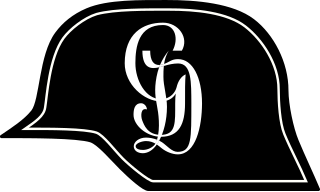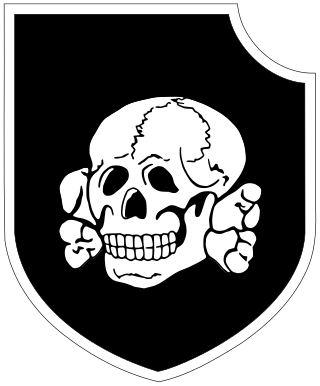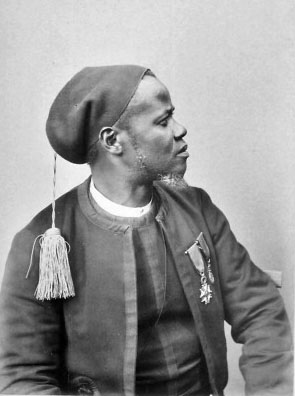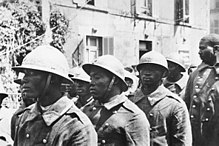
The Panzergrenadier Division "Großdeutschland", also commonly referred to simply as Großdeutschland or Großdeutschland Division, was an elite combat unit of the German Army that fought on the Eastern Front in World War II.

Charles N'Tchoréré was a Gabonese French military officer who was shot by Germans in World War II.

The 3rd SS Panzer Division "Totenkopf" was an elite division of the Waffen-SS of Nazi Germany during World War II, formed from the Standarten of the SS-TV. Its name, Totenkopf, is German for "death's head" – the skull and crossbones symbol – and it is thus sometimes referred to as the Death's Head Division.
The 7th Panzer Division was an armored formation of the German Army in World War II. It participated in the Battle of France, the invasion of the Soviet Union, the occupation of Vichy France, and on the Eastern Front until the end of the war. The 7th Panzer Division is also known by its nickname, Ghost Division.
During World War II, the Allies committed legally proven war crimes and violations of the laws of war against either civilians or military personnel of the Axis powers. At the end of World War II, many trials of Axis war criminals took place, most famously the Nuremberg Trials and Tokyo Trials. In Europe, these tribunals were set up under the authority of the London Charter, which only considered allegations of war crimes committed by people who acted in the interests of the Axis powers. Some war crimes involving Allied personnel were investigated by the Allied powers and led in some instances to courts-martial. Some incidents alleged by historians to have been crimes under the law of war in operation at the time were, for a variety of reasons, not investigated by the Allied powers during the war, or were investigated but not prosecuted.

During World War II, the German Wehrmacht committed systematic war crimes, including massacres, mass rape, looting, the exploitation of forced labour, the murder of three million Soviet prisoners of war, and participated in the extermination of Jews. While the Nazi Party's own SS forces was the organization most responsible for the genocidal killing of the Holocaust, the regular armed forces of the Wehrmacht committed many war crimes of their own, particularly on the Eastern Front.

The Military Administration in France was an interim occupation authority established by Nazi Germany during World War II to administer the occupied zone in areas of northern and western France. This so-called zone occupée was established in June 1940, and renamed zone nord in November 1942, when the previously unoccupied zone in the south known as zone libre was also occupied and renamed zone sud.

The Senegalese Tirailleurs were a corps of colonial infantry in the French Army. They were initially recruited from Senegal, French West Africa and subsequently throughout Western, Central and Eastern Africa: the main sub-Saharan regions of the French colonial empire. The noun tirailleur, which translates variously as 'skirmisher', 'rifleman', or 'sharpshooter', was a designation given by the French Army to indigenous infantry recruited in the various colonies and overseas possessions of the French Empire during the 19th and 20th centuries.

The governments of the German Empire and Nazi Germany ordered, organized, and condoned a substantial number of war crimes, first in the Herero and Namaqua genocide and then in the First and Second World Wars. The most notable of these is the Holocaust, in which millions of European Jewish, Polish, and Romani people were systematically abused, deported, and murdered. Millions of civilians and prisoners of war also died as a result of German abuses, mistreatment, and deliberate starvation policies in those two conflicts. Much of the evidence was deliberately destroyed by the perpetrators, such as in Sonderaktion 1005, in an attempt to conceal their crimes.

Sieg im Westen is a 1941 Nazi propaganda film.
While black people in Nazi Germany were never subject to an organized mass extermination program, as in the cases of Jews, homosexuals, Romani, and Slavs, they were still considered by the Nazis to be an inferior race and along with Romani people were subject to the Nuremberg Laws under a supplementary decree. There is evidence that at least two dozen black Germans ended up in concentration camps in Germany.
The Army of the Levant identifies the armed forces of France and then Vichy France which occupied, and were in part recruited from, the French Mandated territories in the Levant during the interwar period and early World War II. The locally recruited Syrian and Lebanese units of this force were designated as the Special Troops of the Levant.

The Thiaroye massacre was a massacre of French West African veterans of the 1940 Battle of France, by French forces on the morning of 1 December 1944. These Tirailleurs Sénégalais units had been recently liberated from prisoner camps and after being repatriated to West Africa, they mutinied against poor conditions and defaulted pay at the Thiaroye military camp, on the outskirts of Dakar, Senegal. Between 35 and over 300 people were killed.

Just before the 20th century began, most of Africa, with the exception of Ethiopia, Somalia and Liberia, was under colonial rule. By the 1980s, most nations were independent. Military systems reflect this evolution in several ways:

Although no precise estimates exist, the number of French soldiers captured by Nazi Germany during the Battle of France between May and June 1940 is generally recognised around 1.8 million, equivalent to around 10 percent of the total adult male population of France at the time. After a brief period of captivity in France, most of the prisoners were deported to Germany. In Germany, prisoners were incarcerated in Stalag or Oflag prison camps, according to rank, but the vast majority were soon transferred to work details (Kommandos) working in German agriculture or industry. Prisoners from the French colonial empire, however, remained in camps in France with poor living conditions as a result of Nazi racial ideologies.

Madagascar, then officially known as French Madagascar, was a French colony at the outbreak of the Second World War, having been under French administration since 1885. It played an important role in the war due to the presence of critically important harbors, the contribution of Malagasy troops, and was also the scene of fighting between Allied and Vichy French forces in 1942. After the fall of France in 1940, Madagascar became a crucial flashpoint in contention between the Free French movement and Vichy France. The island was also consequential in the Pacific theater of the war as Imperial Japanese naval forces operated unopposed off the island for some time.

Tata of Chasselay is a cemetery in the city of Chasselay, Rhône including almost 200 graves of Senegalese Tirailleurs murdered during the Chasselay massacre of World War II.

Hivernage was the practice in the French Army of withdrawing sub-Saharan African colonial troops from colder theatres to overwinter in warmer climates. Such troops were first deployed to Morocco from 1908 and losses were experienced due to disease in colder weather. When the Senegalese Tirailleurs were deployed to France in 1914 for the First World War an informal hivernage system was implemented, with the troops withdrawn to southern France and northern Africa over winter. The system was formalised in 1915, at the instigation of black deputy Blaise Diagne, with the troops to be withdrawn between November and March. In some cases troops, particularly tirailleurs malgaches, were able to remain in the field all year round.

During the German invasion of Poland, which started World War II, Nazi Germany carried out a number of atrocities involving Polish prisoners of war (POWs). During that period, the Wehrmacht is estimated to have mass murdered at least 3,000 Polish POWs, with the largest atrocities being the Ciepielów massacre of 8 September 1939 and the Zambrów massacre of 13–14 September. Most of those atrocities are classified as war crimes of the Wehrmacht. Jewish soldiers with the Polish Army were also more likely than others to be victims of various atrocities.
The Bois d'Eraine massacre was a war crime carried out by the German Wehrmacht in June 1940 during the German invasion of France. On 11 June 1940, soldiers of the Infantry Regiment Großdeutschland executed around 74 prisoners belonging to the 4e Division d'Infanterie Coloniale of the French army near the town of Cressonsacq in the Oise Department. The massacre followed the killing of 150-500 captured French soldiers, mostly black tirailleurs from French West Africa, in the towns of Angivilliers, Erquinvilliers and Lieuvilliers between 9 and 11 June. It is believed that between 1,500 and 3,000 soldiers from the French colonies were killed in war crimes carried out by the Wehrmacht in 1940.

















